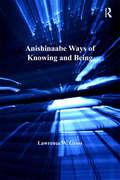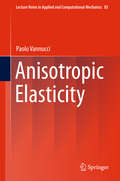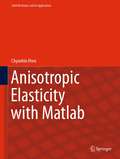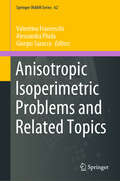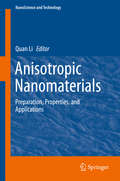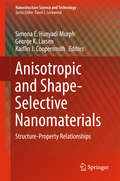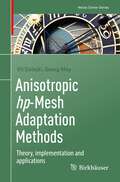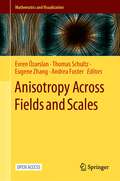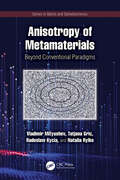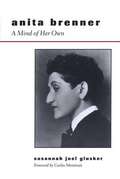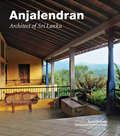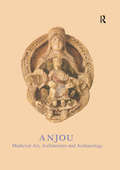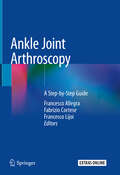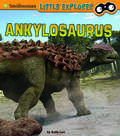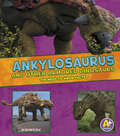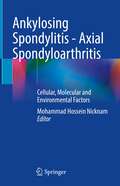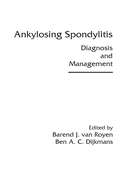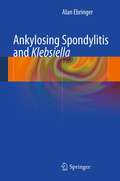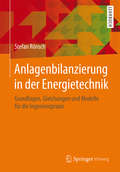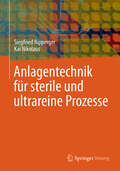- Table View
- List View
Anishinaabe Ways of Knowing and Being (Vitality of Indigenous Religions)
by Lawrence W. GrossVery few studies have examined the worldview of the Anishinaabeg from within the culture itself and none have explored the Anishinaabe worldview in relation to their efforts to maintain their culture in the present-day world. This book fills that gap. Focusing mainly on the Minnesota Anishinaabeg, Lawrence Gross explores how their worldview works to create a holistic way of living. However, as Gross also argues, the Anishinaabeg saw the end of their world early in the 20th century and experienced what he calls 'postapocalypse stress syndrome.' As such, the book further explores how the values engendered by the worldview of the Anishinaabeg are finding expression in the modern world as they seek to rebuild their society.
Anisotropic Elastic Plates
by Chyanbin HwuAs structural elements, anisotropic elastic plates find wide applications in modern technology. The plates here are considered to be subjected to not only inplane load but also transverse load. In other words, both plane and plate bending problems as well as the stretching-bending coupling problems are all explained in this book. In addition to the introduction of the theory of anisotropic elasticity, several important subjects have are discussed in this book such as interfaces, cracks, holes, inclusions, contact problems, piezoelectric materials, thermoelastic problems and boundary element analysis.
Anisotropic Elasticity (Lecture Notes in Applied and Computational Mechanics #85)
by Paolo VannucciThis book presents a modern and unconventional introduction to anisotropy. The first part presents a general description of Anisotropic Elasticity theories while the second part focuses on the polar formalism: the theoretical bases and results are completely developed along with applications to design problems of laminated anisotropic structures. The book is based on lectures on anisotropy which have been held at Ecole Polytechnique in Paris.
Anisotropic Elasticity with Matlab (Solid Mechanics and Its Applications #267)
by Chyanbin HwuThis book provides the theory of anisotropic elasticity with the computer program for analytical solutions as well as boundary element methods. It covers the elastic analysis of two-dimensional, plate bending, coupled stretching-bending, and three-dimensional deformations, and is extended to the piezoelectric, piezomagnetic, magnetic-electro-elastic, viscoelastic materials, and the ones under thermal environment. The analytical solutions include the solutions for infinite space, half-space, bi-materials, wedges, interface corners, holes, cracks, inclusions, and contact problems. The boundary element solutions include BEMs for two-dimensional anisotropic elastic, piezoelectric, magnetic-electro-elastic, viscoelastic analyses, and their associated dynamic analyses, as well as coupled stretching-bending analysis, contact analysis, and three-dimensional analysis. This book also provides source codes and examples for all the presenting analytical solutions and boundary element methods. The program is named as AEPH (Anisotropic Elastic Plates – Hwu), which contains 204 MATLAB functions.
Anisotropic Isoperimetric Problems and Related Topics (Springer INdAM Series #62)
by Valentina Franceschi Alessandra Pluda Giorgio SaraccoThis book contains contributions from speakers at the "Anisotropic Isoperimetric Problems & Related Topics" conference in Rome, held from Sep 5 to 9, 2022. The classic isoperimetric problem has fascinated mathematicians of all eras, starting from the ancient Greeks, due to its simple statement: what are the sets of a given volume with minimal perimeter? The problem is mathematically well understood, and it plays a crucial role in explaining physical phenomena such as soap bubble shapes. Variations of the problem, including weighted counterparts with density dependencies, representing inhomogeneity and anisotropy of the medium, broaden its applicability, even in non-Euclidean environments, and they allow for descriptions, e.g., of crystal shapes. At large, the perimeter's physical interpretation is that of an attractive force; hence, it also appears in describing systems of particles where a balance between attractive and repulsive forces appears. A prominent example is that of Gamow's liquid drop model for atomic nuclei, where protons are subject to the strong nuclear attractive force (represented by the perimeter) and the electromagnetic repulsive force (represented by a nonlocal term). Such a model has been shown to be sound, as it explains the basic characteristics of the nuclei, and it successfully predicts nuclear fission for nuclei with a large atomic number. Similar energy functionals model various physical and biological systems, showcasing the competition between short-range interfacial and long-range nonlocal terms, leading to pattern formation. The authors mention, e.g., the Ohta–Kawasaki model for microphase separation of diblock copolymers and the Yukawa potential for colloidal systems. Despite diverse systems, the emergence of microphases follows similar patterns, although rigorously proving this phenomenon remains a challenge. The book collects several contributions within these topics, shedding light on the current state of the art.
Anisotropic Metal Chalcogenide Nanomaterials: Synthesis, Assembly, And Applications (SpringerBriefs in Materials)
by Geon Dae MoonThis book explores the recent advances in designing and synthesizing one- and two-dimensional metal chalcogenide nanostructures, along with their practical applications, helping readers understand what has happened, and what is currently happening in the field of nanotechnology. It also includes a comprehensive table showing 1D and 2D nanostructured metal chalcogenides, which presents the recent developments from a synthetic point of view. Further, it describes the wide applicability of anisotropic metal chalcogenides, such as in electronics, energy storage and conversion, and sensors. Lastly it discusses the current understanding of the thermodynamic and kinetic aspects associated with the forming mechanisms of anisotropic metal chalcogenide nanostructures. This book is a valuable reference resource for practitioners and researchers, enabling them to obtain a quick overview of anisotropic metal chalcogenide nanomaterials through synthetic approaches and related applications. Presenting representative applications of anisotropic metal chalcogenide nanomaterials that are important in the industrial sector, it is also of interest to academics and industry specialists.
Anisotropic Nanomaterials: Preparation, Properties, and Applications (NanoScience and Technology)
by Quan LiIn this book anisotropic one-dimensional and two-dimensional nanoscale building blocks and their assembly into fascinating and qualitatively new functional structures embracing both hard and soft components are explained. Contributions from leading experts regarding important aspects like synthesis, assembly, properties and applications of the above materials are compiled into a reference book. The anisotropy, i. e. the direction-dependent physical properties, of materials is fascinating and elegant and has sparked the quest for anisotropic materials with useful properties. With such a curiosity, material scientists have ventured into the realm of nanometer length scale and have explored the anisotropic nanoscale building blocks such as metallic and nonmetallic particles as well as organic molecular aggregates. It turns out that the anisotropic nanoscale building blocks, in addition to direction-dependent properties, exhibit dimension and morphology dependence of physical properties. Moreover, ordered arrays of anisotropic nanoscale building blocks furnish novel properties into the resulting system which would be entirely different from the properties of individual ones. Undoubtedly, these promising properties have qualified them as enabling building blocks of 21st century materials science, nanoscience and nanotechnology. Readers will find this book professionally valuable and intellectually stimulating in the rapidly emerging area of anisotropic nanomaterials. Quan Li, Ph. D. , is Director of the Organic Synthesis and Advanced Materials Laboratory at the Liquid Crystal Institute of Kent State University, where he is also Adjunct Professor in the Chemical Physics Interdisciplinary Program. He has directed research projects funded by US Air Force Research Laboratory (AFRL), US Air Force Office of Scientific Research (AFSOR), US Army Research Office (ARO), US Department of Defense Multidisciplinary University Research Initiative (DoD MURI), US National Science Foundation (NSF), US Department of Energy (DOE), US National Aeronautics and Space Administration (NASA), Ohio Third Frontier, and Samsung Electronics, among others.
Anisotropic and Shape-Selective Nanomaterials: Structure-Property Relationships (Nanostructure Science and Technology)
by Simona E. Hunyadi Murph George K. Larsen Kaitlin J. CoopersmithThis book reviews recent advances in the synthesis, characterization, and physico-chemical properties of anisotropic nanomaterials. It highlights various emerging applications of nanomaterials, including sensing and imaging, (bio)medical applications, environmental protection, plasmonics, catalysis, and energy. It provides an excellent and comprehensive overview of the effect that morphology and nanometric dimension has on the physico-chemical properties of various materials and how this leads to novel applications.
Anisotropic hp-Mesh Adaptation Methods: Theory, implementation and applications (Nečas Center Series)
by Vít Dolejší Georg MayMesh adaptation methods can have a profound impact on the numerical solution of partial differential equations. If devised and implemented properly, adaptation significantly reduces the size of the algebraic systems resulting from the discretization, while ensuring that applicable error tolerances are met. In this monograph, drawing from many years of experience, the authors give a comprehensive presentation of metric-based anisotropic hp-mesh adaptation methods.A large part of this monograph is devoted to the derivation of computable interpolation error estimates on simplicial meshes, which take into account the geometry of mesh elements as well as the anisotropic features of the interpolated function. These estimates are then used for the optimization of corresponding finite element spaces in a variety of settings. Both steady and time dependent problems are treated, as well as goal-oriented adaptation. Practical aspects of implementation are also explored, including several algorithms. Many numerical experiments using the discontinuous Galerkin method are presented to illustrate the performance of the adaptive techniques.This monograph is intended for scientists and researchers, including doctoral and master-level students. Portions of the text can also be used as study material for advanced university lectures concerning a posteriori error analysis and mesh adaptation.
Anisotropy Across Fields and Scales (Mathematics and Visualization)
by Thomas Schultz Andrea Fuster Evren Özarslan Eugene ZhangThis open access book focuses on processing, modeling, and visualization of anisotropy information, which are often addressed by employing sophisticated mathematical constructs such as tensors and other higher-order descriptors. It also discusses adaptations of such constructs to problems encountered in seemingly dissimilar areas of medical imaging, physical sciences, and engineering. Featuring original research contributions as well as insightful reviews for scientists interested in handling anisotropy information, it covers topics such as pertinent geometric and algebraic properties of tensors and tensor fields, challenges faced in processing and visualizing different types of data, statistical techniques for data processing, and specific applications like mapping white-matter fiber tracts in the brain.The book helps readers grasp the current challenges in the field and provides information on the techniques devised to address them. Further, it facilitates the transfer of knowledge between different disciplines in order to advance the research frontiers in these areas.This multidisciplinary book presents, in part, the outcomes of the seventh in a series of Dagstuhl seminars devoted to visualization and processing of tensor fields and higher-order descriptors, which was held in Dagstuhl, Germany, on October 28–November 2, 2018.
Anisotropy of Metamaterials: Beyond Conventional Paradigms (Series in Optics and Optoelectronics)
by Vladimir Mityushev Natalia Rylko Tatjana Gric Radoslaw KyciaAnisotropy of Metamaterials: Beyond Conventional Paradigms provides a comprehensive introduction to the mathematical modeling of metamaterials based on the macroscopic complex-valued permittivity tensor of dispersed random composites. Key topics include physical and mathematical theory, computer simulations, constructive homogenization, classification of dispersed random composites and their applications in cancer recognition. Image processing and machine learning algorithms are used. The book also discusses the precision of various effective medium approximations, including Bruggeman and Maxwell-Garnett formulas. New analytical, approximate and exact formulas and bounds for the macroscopic permittivity and piezoelectric constants of composites are derived. This book is a valuable tool for academics and professionals in photonics, presenting sustainable materials for sensing, health diagnostics and cancer detection methodologies.Key features: Offers key insights into the current trends and techniques in the study of the macroscopic properties of metamaterials, aiming at stimulating new avenues of research Presents examples of image analysis, the primary tool for non-destructive metamaterials analysis Discusses the applications of Machine Learning to image processing, illustrated using specific code in Python programming language
Anita Brenner: A Mind of Her Own
by Susannah Joel GluskerJournalist, historian, anthropologist, art critic, and creative writer, Anita Brenner was one of Mexico's most discerning interpreters. In this book, her daughter, Susannah Glusker, traces Brenner's intellectual growth and achievements from the 1920s through the 1940s. This intellectual biography brings to light a complex, fascinating woman who bridged many worlds--the United States and Mexico, art and politics, professional work and family life. Journalist, historian, anthropologist, art critic, and creative writer, Anita Brenner was one of Mexico's most discerning interpreters. Born to a Jewish immigrant family in Mexico a few years before the Revolution of 1910, she matured into an independent liberal who defended Mexico, workers, and all those who were treated unfairly, whatever their origin or nationality. In this book, her daughter, Susannah Glusker, traces Brenner's intellectual growth and achievements from the 1920s through the 1940s. Drawing on Brenner's unpublished journals and autobiographical novel, as well as on her published writing, Glusker describes the origin and impact of Brenner's three major books, Idols Behind Altars, Your Mexican Holiday, and The Wind That Swept Mexico. Along the way, Glusker traces Brenner's support of many liberal causes, including her championship of Mexico as a haven for Jewish immigrants in the early 1920s. This intellectual biography brings to light a complex, fascinating woman who bridged many worlds--the United States and Mexico, art and politics, professional work and family life.
Anjalendran
by David Robson Waruna GomisDuring the past 25 years of civil war in Sri Lanka, Anjalendran has stayed on, creating architecture that has attracted interest across the entire Indian subcontinent.In Anjalendran, David Robson explores this unique man and his uncommon vision. Anjalendran's buildings have a simple directness and although totally modern in spirit, they acknowledge the rich traditions of Sri Lanka. Whether working with ample budgets or at rock bottom cost (like his SOS Children's Village orphanages), his work focuses not only on creative buildings, but-:a la Frank Lloyd Wright-:also their landscaping, furniture and decoration.Just as interesting as the architecture is the process by which Anjalendran works-:from home, never employing more than four student assistants, with no office, no secretary, no car and no cell phone. He operates without a bank account and has never signed a contract with either a client or a builder. With stunning color photographs, plan details and behind-the-scenes insights, Anjalendran sheds light on the works of this exceptional man.
Anjalendran
by David Robson Waruna GomisDuring the past 25 years of civil war in Sri Lanka, Anjalendran has stayed on, creating architecture that has attracted interest across the entire Indian subcontinent.In Anjalendran, David Robson explores this unique man and his uncommon vision. Anjalendran's buildings have a simple directness and although totally modern in spirit, they acknowledge the rich traditions of Sri Lanka. Whether working with ample budgets or at rock bottom cost (like his SOS Children's Village orphanages), his work focuses not only on creative buildings, but-:a la Frank Lloyd Wright-:also their landscaping, furniture and decoration.Just as interesting as the architecture is the process by which Anjalendran works-:from home, never employing more than four student assistants, with no office, no secretary, no car and no cell phone. He operates without a bank account and has never signed a contract with either a client or a builder. With stunning color photographs, plan details and behind-the-scenes insights, Anjalendran sheds light on the works of this exceptional man.
Anjou: Medieval Art, Architecture and Archaeology (The\british Archaeological Association Conference Transactions Ser. #Vol. 26)
by John McNeillThis volume serves as an essential reference for new thoughts, interpretation and discussion of the rich architectural and archaeological heritage of Anjou. It outlines the development of building techniques in Anjou and Touraine, and concentrates on the medieval period.
Ankho Ki Chamak
by Arvind GuptaArvind Gupta, the author, is the winner of the National Award for Science Popularisation amongst children (1988) and the distinguished alumnus award from IIT Kanpur.(2000). Arvind has dedicated his life to teaching science to underprivileged children in rural ares by employing simple stories and toys. Here is one such treasure.
Ankle Arthroscopy: Techniques Developed by the Amsterdam Foot and Ankle School
by C. Niek DijkAnkle injuries are often sport related and pose a diagnostic and therapeutic challenge. Over the past 25 years, Niek van Dijk, founder of the Amsterdam Foot and Ankle School and author of this book, has developed a new philosophy of ankle arthroscopy. It entails a comprehensive approach which includes various diagnostic strategies and the application of a number of minimally invasive endoscopic techniques. Use of these techniques has spread throughout the world; they are now recognized as the state of the art and have been used to treat many leading professional athletes. This diagnostic and operating manual presents the Amsterdam Foot and Ankle School approach for a wide variety of ankle and hindfoot problems. Clear step-by-step instructions are provided with the help of numerous high-quality illustrations, most of which are in color. Access to a web-based educational site is also available to readers.
Ankle Joint Arthroscopy: A Step-by-Step Guide
by Francesco Allegra Fabrizio Cortese Francesco LijoiThis book provides a comprehensive overview of current arthroscopic techniques for the management of ankle joint disorders. An introductory section clearly and accessibly explains the anatomy in question, the portal placement and other ankle procedures, addressing both the articular and extra-articular compartments. All currently available minimally invasive surgical options and the management of various upper and lower lesions of the ankle are then described step by step, discussing the main issues concerning each of them and sharing useful tips and tricks. A closing chapter is devoted to rehabilitation, which greatly differs in patients treated with arthroscopic procedures and those undergoing open surgery. The volume is also supplemented by detailed videos for each technique and procedure, both outside on the cutaneous layer and inside the joint. The book offers an invaluable tool for orthopedic surgeons and fellows dealing with foot and ankle disorders who normally prefer to use open procedures and desire to complement their surgical options with arthroscopy, as well as for those surgeons already familiar with arthroscopic techniques who would like to broaden their knowledge of the field.
Ankylosaurus (Little Paleontologist Ser.)
by AnkylosaurusExplore the world of the Ankylosaurus, a plant loving dinosaur that walked this planet over 65 million years ago! From its club tail to its armored body, find out what made this ancient lizard thrive in the Cretaceous Period.
Ankylosaurus and Other Armored Dinosaurs: The Need-to-know Facts (Dinosaur Fact Dig Ser.)
by Kathryn ClayAnkylosaurus and other armored dinosaurs were the tanks of the prehistoric world. Sharp spikes and rock-hard plates protected these plant eaters from dangerous predators. Bold images, colorful maps, and interesting facts take readers back to a time when armored dinosaurs walked the earth.
Ankylosing Spondylitis - Axial Spondyloarthritis: Cellular, Molecular and Environmental Factors
by Mohammad Hossein NicknamAnkylosing Spondylitis is a chronic autoimmune disease that affects about 1-3% of the world population. This debilitating disease affecting primarily young males exerts considerable socio-economic consequences. The exact pathogenesis of AS has not yet been fully understood; therefore, novel, detailed information sources are required. This book offers cutting-edge knowledge about the molecular basic and immunological mechanisms involved in the pathogenesis of Ankylosing Spondylitis. It is one of the scarce scientific resources discussing the environmental factors triggering the disease, along with the clinical manifestations, diagnostic methods, and treatments. This book covers the most recent and reliable researches and developments about spondyloarthropathies in order to provide elaborated, integrated guidance on the molecular mechanisms of Spondyloarthropathies. It will prove helpful for rheumatologists, immunologists, biologists, geneticists, and medical science students who wish to learn more about SpAs.
Ankylosing Spondylitis: Diagnosis and Management
by Barend J. Van Royen Ben A. C. DijkmansThe first and only interdisciplinary guide dedicated to the subject, this reference leads readers through the pathogenic, genetic, clinical, and biomechanical aspects of ankylosing spondylitis (AS) and addresses issues related to outcomes assessment, medical treatment, surgical complications, disease management, and genetics.
Ankylosing spondylitis and Klebsiella
by Alan EbringerAnkylosing spondylitis and Klebsiella is a comprehensive and informative text on the cause of Ankylosing spondylitis. Ankylosing spondylitis (AS) is a condition which affects 20 million people worldwide and is likely caused or initiated by a bowel infection from Klebsiella bacteria. When a patient is infected by Klebsiella bacteria, his or her immune system will make antibodies against all the antigens or molecules found in the microbe. Because some of the bacterial antigens resemble self tissues, the anti-bacterial antibodies will attack not only the bacteria but also the self tissues such as the joints and the cells having the same HLA molecules, which is how the disease AS starts. This is the concept of molecular similarity or "molecular mimicry" which previously has been found to work in two other autoimmune diseases; rheumatic fever and rheumatoid arthritis. The first paper on this subject was published in 1976 and since then over 100 papers on rheumatological topics have been published, from Prof Ebringer's group, at the Division of Life Sciences, King's College in London, UK. The relevant information from these papers is extracted and presented in this book format making it accessible to health professionals, research institutions, pharmaceutical companies and universities and the general public.
Anlagenbilanzierung in der Energietechnik: Grundlagen, Gleichungen und Modelle für die Ingenieurpraxis
by Stefan RönschDieses Lehrbuch beschreibt ausführlich das Vorgehen und die Methodik von Anlagenbilanzierungen in der Energietechnik. Studenten und Ingenieuren wird damit ein umfangreiches Rüstzeug zur Planung und Optimierung der Anlagen an die Hand gegeben. Neben Grundgleichungen, Modellierungsansätzen und numerischen Methoden wird die stoffliche und energetische Bilanzierung anhand einer Vielzahl von Beispielrechnungen ausgeführt. Das Buch spannt dabei einen Bogen von der Funktionsweise der Komponenten über die Grundlagen der Thermodynamik, Reaktionsrechnung, Phasengleichgewichtsrechnung und Stoffwertberechnung bis hin zur computergestützten Umsetzung. Beachtung finden alle relevanten Anlagenkomponenten der Energietechnik wie Brennkammern, Turbinen, Kompressoren, Wärmetauscher, Gleichgewichtsstufen und Synthesereaktoren.
Anlagentechnik für sterile und ultrareine Prozesse
by Siegfried Ripperger Kai NikolausDieses Fachbuch beschreibt die Grundlagen zur Gestaltung von Apparaten für die sterile Prozesstechnik unter Beachtung der aktuellen Regeln und Vorschriften. Unter dem Begriff sterile Prozesstechnik werden die spezifischen Randbedingungen der Apparate- und Anlagentechnik für die Lebensmittel-, Pharma- und Bioverfahrenstechnik zusammengefasst. Diese ergeben sich aus dem möglichen Verderb der zu verarbeitenden Produkte und den dadurch zu beachtenden hygienischen Anforderungen. Die Anforderungen, die sich aus der Reinigung und Desinfektion bzw. Sterilisation der Anlagen ergeben sowie die zugehörigen Regeln zum „Hygienic Design“ der Anlagen werden ausführlich behandelt. Beschrieben werden außerdem die hierbei zu beachtenden speziellen regulatorischen Aspekte und die erarbeiteten technischen Regeln, die über die des üblichen Anlagenbaus hinausgehen. Zunehmend kommen Single-Use-Elemente im Zusammenhang mit der sterilen Prozesstechnik zur Anwendung, daher wurde diesem Trend ein eigenes Kapitel gewidmet.
